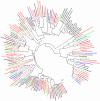Repertoire of intensive care unit pneumonia microbiota
- PMID: 22389704
- PMCID: PMC3289664
- DOI: 10.1371/journal.pone.0032486
Repertoire of intensive care unit pneumonia microbiota
Expression of concern in
-
Expression of Concern: Repertoire of Intensive Care Unit Pneumonia Microbiota.PLoS One. 2022 Dec 13;17(12):e0277633. doi: 10.1371/journal.pone.0277633. eCollection 2022. PLoS One. 2022. PMID: 36512524 Free PMC article. No abstract available.
Abstract
Despite the considerable number of studies reported to date, the causative agents of pneumonia are not completely identified. We comprehensively applied modern and traditional laboratory diagnostic techniques to identify microbiota in patients who were admitted to or developed pneumonia in intensive care units (ICUs). During a three-year period, we tested the bronchoalveolar lavage (BAL) of patients with ventilator-associated pneumonia, community-acquired pneumonia, non-ventilator ICU pneumonia and aspiration pneumonia, and compared the results with those from patients without pneumonia (controls). Samples were tested by amplification of 16S rDNA, 18S rDNA genes followed by cloning and sequencing and by PCR to target specific pathogens. We also included culture, amoeba co-culture, detection of antibodies to selected agents and urinary antigen tests. Based on molecular testing, we identified a wide repertoire of 160 bacterial species of which 73 have not been previously reported in pneumonia. Moreover, we found 37 putative new bacterial phylotypes with a 16S rDNA gene divergence ≥ 98% from known phylotypes. We also identified 24 fungal species of which 6 have not been previously reported in pneumonia and 7 viruses. Patients can present up to 16 different microorganisms in a single BAL (mean ± SD; 3.77 ± 2.93). Some pathogens considered to be typical for ICU pneumonia such as Pseudomonas aeruginosa and Streptococcus species can be detected as commonly in controls as in pneumonia patients which strikingly highlights the existence of a core pulmonary microbiota. Differences in the microbiota of different forms of pneumonia were documented.
Conflict of interest statement
Figures





References
-
- Esperatti M, Ferrer M, Theessen A, Liapikou A, Valencia M, et al. Nosocomial Pneumonia in the Intensive Care Unit Acquired during Mechanical Ventilation or Not. Am J Respir Crit Care Med 2010 - PubMed
-
- Potgieter PD, Hammond JM. Etiology and diagnosis of pneumonia requiring ICU admission. Chest. 1992;101:199–203. - PubMed
-
- Guidelines for the management of adults with hospital-acquired, ventilator-associated, and healthcare-associated pneumonia. Am J Respir Crit Care Med. 2005;171:388–416. - PubMed
-
- Chiche L, Forel JM, Roch A, Guervilly C, Pauly Vl, et al. Active cytomegalovirus infection is common in mechanically ventilated medical intensive care unit patients. Crit Care Med. 2009;37:1850–1857. - PubMed
-
- Papazian L, Fraisse A, Garbe L, Zandotti C, Thomas P, et al. Cytomegalovirus. An unexpected cause of ventilator-associated pneumonia. Anesthesiology. 1996;84:280–287. - PubMed
Publication types
MeSH terms
Substances
Associated data
- Actions
- Actions
- Actions
- Actions
- Actions
- Actions
- Actions
- Actions
- Actions
- Actions
- Actions
- Actions
- Actions
- Actions
- Actions
- Actions
- Actions
- Actions
- Actions
- Actions
- Actions
- Actions
- Actions
- Actions
- Actions
- Actions
- Actions
- Actions
- Actions
- Actions
- Actions
- Actions
- Actions
- Actions
- Actions
- Actions
- Actions
- Actions
- Actions
- Actions
- Actions
- Actions
- Actions
- Actions
- Actions
- Actions
- Actions
- Actions
- Actions
- Actions
- Actions
- Actions
- Actions
- Actions
- Actions
- Actions
- Actions
- Actions
- Actions
- Actions
- Actions
- Actions
- Actions
- Actions
- Actions
- Actions
- Actions
- Actions
- Actions
- Actions
- Actions
- Actions
- Actions
- Actions
- Actions
- Actions
- Actions
- Actions
- Actions
- Actions
- Actions
- Actions
- Actions
- Actions
- Actions
- Actions
- Actions
- Actions
- Actions
- Actions
- Actions
- Actions
- Actions
- Actions
- Actions
- Actions
- Actions
- Actions
- Actions
- Actions
- Actions
- Actions
- Actions
- Actions
- Actions
- Actions
- Actions
- Actions
- Actions
- Actions
- Actions
- Actions
- Actions
- Actions
- Actions
- Actions
- Actions
- Actions
- Actions
- Actions
- Actions
- Actions
- Actions
- Actions
- Actions
- Actions
- Actions
- Actions
- Actions
- Actions
- Actions
- Actions
- Actions
- Actions
- Actions
- Actions
- Actions
- Actions
- Actions
- Actions
- Actions
- Actions
- Actions
- Actions
- Actions
- Actions
- Actions
- Actions
- Actions
- Actions
- Actions
- Actions
- Actions
- Actions
- Actions
- Actions
- Actions
- Actions
- Actions
- Actions
- Actions
- Actions
- Actions
- Actions
- Actions
- Actions
- Actions
- Actions
- Actions
- Actions
- Actions
- Actions
- Actions
- Actions
- Actions
- Actions
- Actions
- Actions
- Actions
- Actions
- Actions
- Actions
- Actions
- Actions
- Actions
- Actions
- Actions
- Actions
- Actions
- Actions
- Actions
- Actions
- Actions
- Actions
- Actions
- Actions
- Actions
LinkOut - more resources
Full Text Sources
Other Literature Sources
Medical
Molecular Biology Databases

